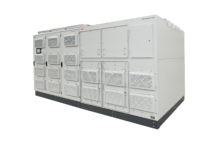Many organisations are unwilling – or unable – to invest in top-of-the line, bespoke UPS to support harsh environmental applications that cost upwards of 10 times the price of a standard system. But surely there has to be a middle ground? Andy Parfitt, sales director of Harland Simon UPS, outlines the value of combining a standard UPS with customised, environment-specific ruggedised protection.
More than 10% of commercial off-the-shelf uninterruptible power suuply systems are actually deployed in non-office harsh environments, protecting sensitive and critical road- and rail-side equipment, operating at sea, in water treatment plants and power stations. Unfortunately, the associated noise, vibration, temperature variation, salt, humidity, dust and dirt in these environments can result in the life expectancy of UPS and batteries plummeting from a typical 10 years to perhaps one or two at best. The resultant cost of maintenance, repair and replacement not only adds hugely to the whole-life cost but can also cause significant operational disruption.
Understanding costs
For any organisation facing finite budget constraints, something has to give. But what? Is it worth providing essential field service staff with standard mobile equipment, especially in challenging areas such as sea, road or rail, rather than shell out for ruggedised devices?
Is it safe to opt for a cheaper commercial UPS to support track-side equipment, despite the huge temperature variation, vibration, EMC, conductive dust and risk of water ingress?
The answer, in both cases, is typicall no. Yet more often than not it takes a few too many failures before the risks and costs associated with non-environment protected devices are finally recognised – and the business implications in the meantime can be serious. UPS failure due to excessive vibration, noise or salty atmosphere can leave ships unable to sail, level crossings shut down or traffic lights permanently on red.
The fact is that while cost reduction is a priority in every industry, in challenging environments that can radically reduce the lifespan of equipment, making decisions based on the purchase cost alone can have long-term repercussions.
System vulnerability
Sensitive electronics equipment is incredibly vulnerable to power problems. While noise and spikes or sags, damp, vibration and temperature variation may be unlikely in an office; they are run of the mill in many other environments.
For the UPS deployed to protect essential marine equipment, for example, the combination of salty water, vibration, dirt, dust and noise can result in lifespan reduced from an expected ten years to just one.
Similarly, with road or rail trackside equipment typical UK outside temperatures can vary from -10°C to over 30°C (with the temperature inside the cabinet at over 40°C or 50°C). The resultant impact on battery life can be devastating.
The fact is that all UPS are not the same and standard commercial devices are not suitable for these harsh environments – and the potential impact of failure is considerable. What happens if the UPS backing up the dynamic positioning system, radar or comms system on a ship blows up because the boards have been damaged by sea air, the connectors broken as a result of vibration or the battery dries out due to heat?
In the worst-case scenario, that ship will actually be prevented from sailing until the equipment is replaced. So much for saving money on a less expensive, off-the-shelf, commercial UPS.
Whole-life cost
The UPS is essentially an insurance policy to ensure critical equipment runs safely and reliably for many years; but it also protects that equipment against power spikes and surges and UPS failure can also lead to damage to that essential equipment. If a failure occurs – either with the UPS, battery or underlying equipment – the problem is not simply one of replacement. The issue is the cost and potential complexity associated with organising repair or maintenance.
Can it be carried out by the in-house service engineers who can simply swap in a new component part or does it require an expensive visit from the manufacturer’s service engineers? How long will it take to get that replacement part – and to schedule the repair? If the product is a standard commercial UPS, is the warranty still valid if the device has been deployed in a harsh environment? Most probably not.
Furthermore, are there other challenges associated with the repair – for example, if the failed UPS is at a railway level crossing, is there a potential impact on the train timetable? Does the repair need to be carried out overnight, for example, and if so, what is the additional cost associated with out-of-hours activity?
When it comes to non-office environments, assessing the overall lifetime cost is far more complex than a simple upfront UPS purchase comparison and, typically, it is the replacement, repair and maintenance costs that far outweigh the unit UPS price.
Despite this, few organisations can justify the purchase of a bespoke UPS designed from the ground up for specific applications. In addition to the cost, the lead time on such devices can be up to 12 months. The alternative is to take a standard, proven commercial UPS and build it into a high ingress protection (IP) rated rugged enclosures or cases designed for specific environments – from sand and rain to shock, vibrations and temperature.
Using this approach keeps the upfront costs low while the additional protection ensures the UPS and battery perform to the 10-year life expectations, minimising both maintenance and replacement costs. Lead times are little longer than standard UPS devices, as are costs. However, the custom assemble to order model ensures the whole lifetime cost of a device is far, far lower.
Conclusion
Today, it is estimated that at least 10% of commercial UPS are actually installed in challenging environments for which they were never designed. The result is that critical equipment, from traffic lights to radar systems, are simply not being adequately protected.
Clearly it is tempting to consider all UPS the same and to make decisions based on upfront cost alone – but the implications for both performance and safety are significant. Failure to take into account the impact of noise, dust, temperature and vibration on both UPS and their batteries and to actively consider the cost and disruption associated by additional maintenance and repair is misguided.
UPS is designed to reduce risk – and it is only by ensuring the right device is deployed for each specific environment that organisations can be confident that risk is being managed effectively – and cost effectively.




